
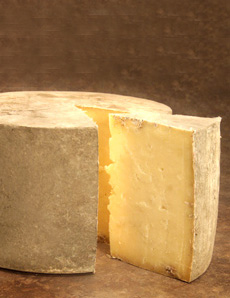 A bandage-wrapped Cheddar from Fiscalini Farmstead. “Bandage” refers to the cloth wrapping around the cheese. A bandage-wrapped Cheddar from Fiscalini Farmstead. “Bandage” refers to the cloth wrapping around the cheese.
May 2005
Last Updated November 2025
|
 |
Cheese Glossary
Types Of Cheese, Terms & Definitions Every Cheese Lover Should Know
Page 3: Cheddar Cheese & Other Terms Beginning With C
This is Page 3 of a 12-page glossary on the types of cheese. Included are terms such as Camembert, Cheddar, and chèvre, plus a definition of cheese and the basic cheese groups. Click on the letters below to find other terms of interest. When you’re finished with cheese, visit our many other food glossaries.
Click on a letter to go to the appropriate glossary section.
a b c d e f g h i j k l m n o p q r s t u v w x y z
This glossary is protected by copyright and cannot be reproduced in whole or in part.
You are welcome to link to it.
CAMBOZOLA
Cambozola is a “new” cheese, created in the 1970s by the Bavarian company Champignon. The name is a blend of Camembert and Gorgonzola, which reflects its fusion of the French soft-ripened cheese with the Italian blue cheese. It’s a bloomy rind cheese similar to Brie or Camembert, with a soft, creamy interior that has streaks of blue-green mold. The taste is much milder than traditional blue cheeses: rich, buttery, and creamy with a gentle blue cheese tang.
Like Brie and Camembert, there are subtle mushroomy, earthy notes from the white mold on the Cambozola rind. When ripe, it’s spreadable and pairs beautifully with fruit (apples, figs, pears), and honey or preserves. It’s also excellent melted on a burger or in a grilled cheese sandwich. For wine pairing, it works well with sweeter wines like Riesling or Port, or a light red.
A similar cheese, created around the same time, is Bavaria Blu, which is vegetarian and lactose-free.
Cambozola is not vegetarian: It's made with traditional animal rennet, so it wouldn't be suitable for vegetarians.
Substitute either of these cheeses for Baked Brie. Here’s a delicious recipe.
National Blue Cheese Day, also known as National Moldy Cheese Day, is celebrated on October 9th. If you haven’t yet tried Cambozola, mark your calendar!
|
 |
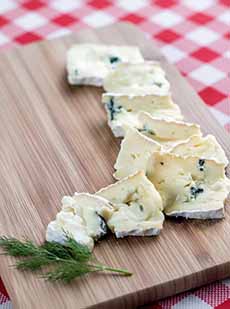
Cambozola, a Brie-like cheese with a vein of blue-green mold (Gemini photo).
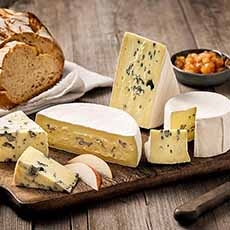
A similar cheese, created around the same time, is Bavaria Blu, which is vegetarian and lactose-free (photo © Bergader). |
Cheese trivia: Cambozola actually uses two Penicillium species. Penicillium camemberti forms the white crust, and Penicillium roqueforti forms the blue veining.
CAMEMBERT
|
Why are Brie and Camembert virtually the same cheese? Legend says that in 1791, during the French Revolution, a priest from the village of Brie (where the cheese was made) arrived in the village of Camembert and was hidden there by Marie Harel, a farmer. Following his direction, she created the bloomy-rind cheese that came to be known as Camembert. Her children and grandchildren continued the cheesemaking, and Camembert became famous worldwide. Camembert’s round wooden box first appeared in 1880, developed to protect the cheese during transportation by rail. Brie and Camembert are two of the few cheeses that stand up to the structured, tannic red Bordeaux. They also pair well with red Burgundies and Côtes du Rhone. See Brie and read the full story, and the difference between Brie and Camembert.
|
 |
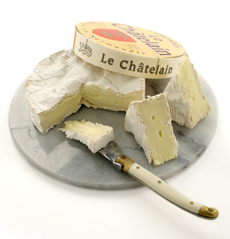
In Normandy, Camembert is served with Calvados. It is excellent with light reds (such as those from the Loire Valley) or Champagne and can also stand up to red Burgundy, Bordeaux, and Côtes du Rhone. Photo courtesy iGourmet.com. |
While there is no universally recognized National Camembert Day, it is sometimes celebrated on April 26th in connection with the invention of Camembert cheese. That’s the birthday of Marie Harel, the farmer credited with inventing Camembert.
CASEIN
Casein is the element of milk that solidifies when coagulation takes place. Caseins are insoluble milk proteins that form suspended masses in milk and thus create emulsions.
CAVE
A room, sometimes underground, where cheeses are left to ripen. Some cheeses, like Roquefort, are ripened in caves, from which they pick up bacteria that give them their distinctive flavors.
CELLAR
A room, sometimes underground, where cheeses are left to ripen. Some cheeses, like Roquefort, are ripened in caves from which they pick up bacteria that give them their distinctive flavors.
|
 |
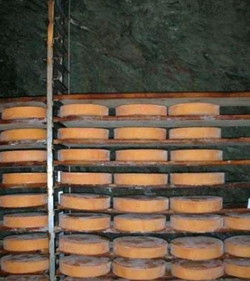
Cheeses ripening in an actual cave. Photo courtesy ForeverCheese.com.
|
CHEDDAR
Cheddar is a hard, sharp cheese with a paste that ranges from pale yellow to deep orange. Originating in the Somerset County village of Cheddar in southwest England around 1170 C.E. or earlier, Cheddar is the most popular type of cheese in the U.K. and accounts for more than half of English cheese production. In the U.S., it ranks #2, behind mozzarella.
The cheese is now made worldwide, and only one producer remains in the village of Cheddar itself. The name is not protected, so cheese made anywhere can be called Cheddar. However, West Country Farmhouse Cheddar has a PDO (Protected domain of Origin) that covers Cheddars made in the traditional manner (raw milk, calf rennet, and a cloth wrapping) in the southwest England counties of Somerset, Devon, Dorset, Cornwall, and Somerset. Strong, extra-mature Cheddar, sometimes called vintage, needs to be matured for up to 15 months. Here’s the history of Cheddar and more about this great cheese. |
|
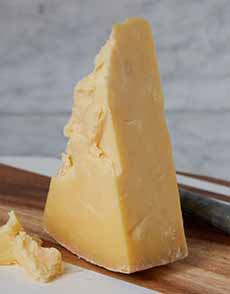
One of the great English Cheddars, Montgomery’s Cheddar from Neal’s Yard Dairy, is hand-formed to create massive, 60-pound cylinders. Fresh cow’s milk curds from the Montgomery Farm in Somerset, England, are wrapped in linen and rubbed with lard before aging for over a year at Neal’s Yard (photo © Murray’s Cheese) |
National Cheddar Day in the U.S. is celebrated on February 13th.
CHEDDARING
|
A cheese production technique where the curd is cut into blocks, which are turned and stacked at the bottom of the cheese vat at intervals of ten to fifteen minutes for about one-and-a-half hours. This is an additional step in the production of Cheddar-style cheeses, and one of the most complex techniques in cheesemaking. (Other cheeses, in addition to Cheddar, are made this way.) The milk is set, cut, cooked lightly, and allowed to mature at a warm temperature. The matting and stacking of blocks of curd allow for the bacteria to consume the lactose in the milk and convert it to lactic acid. This acidifies the cheese and creates a sharp flavor. The curds become stringy and are then shredded, salted, and pressed into drums for about 24 hours. Examples include Cheddar, Cantal, and Salers. A bonus for the lactose intolerant: During the cheddaring process, much of the lactose disappears.
|
 |
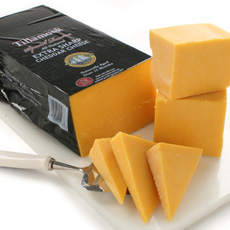
From Oregon, Tillamook Extra-sharp Cheddar has an orange paste (from annatto). Available at iGourmet.com. See the award-winning macaroni and cheese recipes made with Tillamook cheddar. |
CHEESE
|
Cheese is a solid food made from the curdled milk of various quadruped mammals. Cheese can be made from the milk of the yak, water buffalo, reindeer, and horse, as well as the cow, goat, and sheep common to American and European cultures. The word cheese comes from the Latin caseus and, later, West Germanic kasjus (in modern German, it is Käse). Cheese was created to store excess milk in a form that would not spoil as rapidly as fresh milk; in a sense, cheese is a controlled spoilage of milk. There are hundreds of types of cheese based on different breeds of cow, goat, and sheep, species of bacteria and molds, different levels of milk fat, variations in the length of aging, and different processing treatments (cheddaring, pulling, brining, and mold washing). Other factors include milk, animal diet, and the addition of herbs and spices that flavor some cheeses.
|
 |
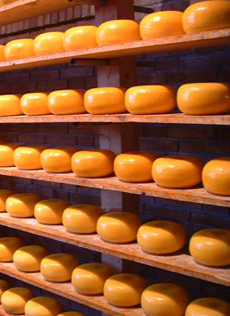
Photo by K. Connors, courtesy of MorgueFile.com. |
The first step in cheesemaking is to coagulate the milk into curds with an acid (vinegar, lemon juice, Cynara cardunculus [a proteinase], or the enzyme rennet, which comes from bovine calf stomach). When rennet is used to set the milk, it can result in a very un-cheeselike cheese, such as fromage blanc, skyr, or quark—all of which have the consistency of yogurt. Yogurt, not made with rennet or other acids, is simply cultured milk (milk with bacterial cultures added) and thus is not a cheese, no matter how similar in taste and appearance it is to the other three products. In cheesemaking, bacteria are added to reduce the pH, alter the texture, and develop flavor. Some cheeses also have mold, either on the outer skin, the interior, or throughout. In some parts of the world (including Wisconsin), where the milk fat is low in beta-carotene, annatto plant dye is used to make the cheese less pale.
CHEESE TYPES
There are eight basic types or styles of cheese, and any cheese can belong to more than one category. From the least aged to the most aged, the groups are:
- Fresh Cheeses. These cheeses are unaged: mild, milky, and tangy. Examples include mascarpone, mozzarella, ricotta, and queso blanco. Read more about fresh cheeses and how to describe them.
- Semisoft Cheeses. These cheeses have a smooth, generally creamy interior with little or no rind. They are generally high in moisture content and range from very mild in flavor to very pungent. Mild semisoft cheeses ripened by bacteria or yeast include Colby, Fontina, Havarti, and Monterey Jack. Pungent semi-soft cheeses, including many of the Washed Rind group, such as Epoisses, Livarot, and Taleggio. Blue-veined cheeses are also semisoft cheeses.
- Soft-Ripened Cheeses. Buttery and creamy, these mild to medium-strong cheeses include the popular Brie and Camembert.
|
 |
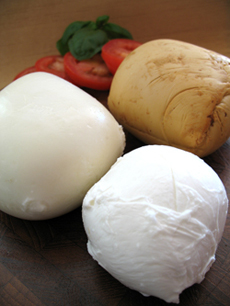
Mozzarella is a fresh (unaged) cheese (photo by Melody Lan | © THE NIBBLE).
|
- Surface-Ripened Cheeses Or Bloomy Rind Cheeses. Creamy, earthy, rich, and runny, these cheeses are mild to medium-strong and include Brie and Camembert as well as triple-crèmes such as Brillat Savarin and Gratte Paille and double-crèmes like Chaource. St. Maure, Selles-sur-Cher, Rocamadour, and Valençay are also part of this group, as are Italian cheeses Robiola, Rocchetta, and La Tur. See also bloomy rind cheeses.
- Semihard Cheeses Or Pressed Cheeses. These cheeses are longer-lasting. The group includes medium-strong cheeses that have buttery, earthy, and fruity flavors—favorites such as Cheddar, Fontina, Gouda, and Gruyère. Other familiar names are Baby Swiss, some blues, Colby, Emmentaler, and other Swiss cheeses, Monterey Jack, Queso Blanco, and some Tilsits. See also pressed cheeses.
|
 |
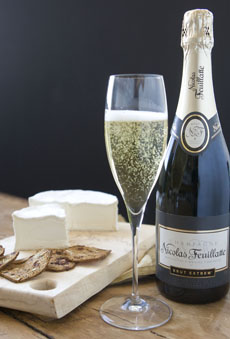
A creamy, surface-ripened cheese like Brillat Savarin goes best with Champagne. Photo courtesy Nicolas Feuilatte. |
- Hard Cheeses. These are aged for the longest period, from one year to more than four years. They have grainy textures and are primarily intended for grating. They are salty, nutty, and sharp, medium-strong to very strong cheeses. Examples include Asiago, Grana Padano, Parmigiano-Reggiano, and Pecorino Romano.
- Blue Veined Cheeses or Blue Cheeses. Delightfully earthy, salty, and pungent, blue-veined cheeses are medium-strong to very strong and include Gorgonzola and Stilton, ripened by Penicillium molds. This group includes Danish Blue (ripened by Penicillium roqueforti), Gorgonzola (Penicillium gorgonzola), Roquefort (Penicillium roqueforti), and Stilton (Penicillium glaucum).
|
 |
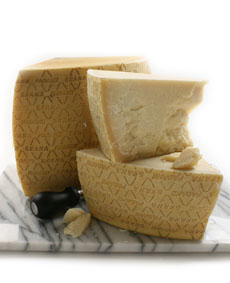
The Hard Cheese group is best for grating. Above, Grana Padano. Photo courtesy iGourmet.com. |
- In addition to the blue veins, these molds provide a distinct flavor profile to the cheese, which ranges from fairly mild to assertive and pungent. Some blue-veined cheeses can be found in the other categories as well, except for fresh cheeses. See also blue cheese.
- Washed Rind Cheeses. Savory, nutty, and salty, these strong to very strong cheeses are distinguished by their pungent aromas, pinkish or orange-colored rinds, and typically semi-soft texture. Examples include Epoisses, munster, and Taleggio. See also washed rind cheeses. (Note that since munster is not a proper name—it derives from the word for monastery—it is not capitalized.)
CHEESEMAKING
Cheesemaking requires extensive training; it is both an art and a science. While the basic steps are similar for most types of cheese, many factors determine the final product, including milk type and quality, environment, particular recipe, and decision-making on the part of the individual cheesemaker, such as that of a chef. Here are the six basic steps common to all cheesemaking:
- Starter cultures are added to the milk to begin acidification or “souring.”
- Rennet is added, which curdles the milk and creates solids, or curds, which have the consistency of custard.
- The curds are cut with knives, called harps. This releases the liquid, whey.
- The whey is drained; the extent of the drainage depends on the consistency of the cheese (e.g., the harder the finished cheese, the more whey is drained).
|
 |
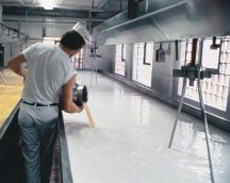
Adding starter culture to the milk is the first step in cheese making. Both photos courtesy of Wisconsin Milk Marketing Board.
|
- The curds are placed into molds and further drained. To make hard cheeses, the curds are pressed under weights to maximize the amount of whey that is pressed out.
- Fresh cheese, which is not aged, is ready to be packaged and shipped to market. Other types of cheese begin aging, for a period that ranges from days to years.
|
 |
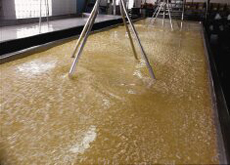
The whey is drained from the curds; then, the curds are placed into molds to shape the cheese.
|
CHEESEMONGER
A distributor who sells cheese to retailers, restaurants, and other establishments. A monger is a broker or dealer. The word monger is usually used in combination with another word, such as in fishmonger.
CHÈVRE or GOAT CHEESE
|
Chèvre (the French word for goat and goat cheese) is characterized by its whiteness and tangy, distinctive flavor. It is unprocessed and (with the exception of fresh chèvres, meant to be eaten within a few days of production) aged for two weeks or more, and often has an edible white rind. The paste varies from creamy to semi-firm. Chèvres are made in a variety of shapes, including cylinders, cones, discs, crottins, logs (bûches), and pyramids. Examples include Crottin and Le Chevrot.
|
 |
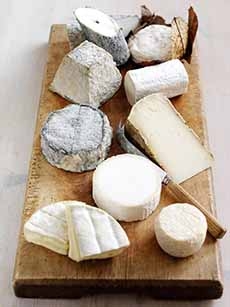 Different types of goat cheese (photo © Goat Cheeses Of France). Different types of goat cheese (photo © Goat Cheeses Of France). |
CLOSE
Used to describe a cheese’s texture: A close-textured cheese is one that is smooth, unblemished, and devoid of holes or cracks. See also open.
COAGULATION
|
Coagulation is the transformation of milk into curd, which is the first step in cheese production. The milk is brought to a temperature of 64°-66°F and a lactic fermenting agent, or starter culture, is added. Rennet is then added to allow the gentle coagulation of the milk over 1 to 2 days (lactic curd). In some cheeses, such as Camembert, three times as much rennet is used so that the milk coagulates more rapidly, in as little as one hour (mixed curd).
|
 |
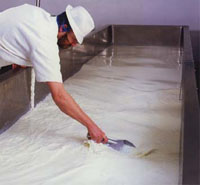
The first step in cheesemaking: mixing the milk, starter, rennet, and, in the case of Stilton, blue cheese mold, to coagulate the curd. Photograph copyright 1997-2004, Stilton Cheesemakers’ Association. All Rights Reserved. |
COLBY
Colby cheese is a mild orange cheese that’s similar to Cheddar in look, taste, and texture. Colby is a dry cheese, slightly crumbly, and like young Cheddar, it’s just slightly sharp. Colby cheese was developed in 1885 in a cheese factory near Colby, Wisconsin, operated by Ambrose Steinwand. His small factory made around 100 pounds of cheese a day—mostly Cheddar. Colby cheese was actually created by Joseph Steinwand, Ambrose’s eldest child, who took a special interest in the intricacies of the cheesemaking process. Through experimentation, he developed Colby.
His process led to a sweeter, milder style of cheese than traditional Cheddar. He aged it for just one to three months, much shorter than most cheddars (and thus, quicker cash flow). Today, Wisconsin’s cheesemakers make over 45 million pounds of Colby each year to share with eager cheese lovers across the world.
|
 |
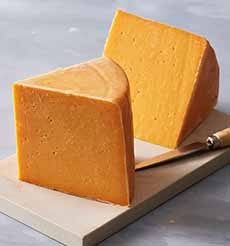
Colby cheese (photo Wisconsin Cheese). |
COMTÉ
|
Made for 1,000 years, Comté is a handmade, artisan cheese governed by strict A.O.C. rules that ensure that each wheel is just as perfect as the last. It is produced in 70-pound wheels from unpasteurized cows’ milk on more than 3,000 family farms in the French Alps. The farmers practice non-intensive agriculture, which focuses on quality rather than the highest possible yields. By law, production must start within 24 hours of milking, so the cheese is made daily. The wheels age on spruce boards for at least six months, where they develop a tight-knit texture and satiny body. On the palate, one can detect notes of fruits, hay, and a slightly nutty, smoky flavor gained during the process when the curd is cooked. “Reserve” wheels are aged for one year, developing sweet and nutty notes. Certain spices complement the aromas and flavors of Comté: a small sprinkle of vanilla beans, curry powder, or nigella seeds, for example. See the difference between Gruyère from Switzerland and Comté from France.
|
 |
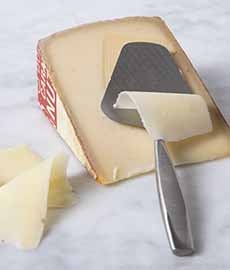
A wedge from a huge wheel of Comté (photo © Murray’s Cheese).
|
COOKED CURD CHEESES or COOKED PRESSED CHEESES
|
Cooking is a step in the cheesemaking process when the cheese curd is heated, sometimes in the surplus whey. Cooked cheeses are all hard cheeses and other Swiss types—traditionally the biggest wheels of cheese from the mountains: Gruyère, Beaufort, and the “cheeses with eyes” like Swiss Emmentaler, the cheese most Americans think of as “Swiss cheese.” (This technique also makes semi-hard cheeses.) The difference between the pressed, cooked, and uncooked cheeses is (of course) the heating/cooking of the curds before the wheels are formed. It is easy to detect those that have been cooked: the paste has a heated, cooked-milk aroma unique to this family of cheese.
|
 |
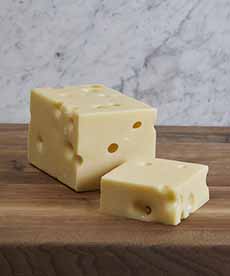
Emmenthaler, also spelled Emmentaler. Made from the milk of high alpine pasture cows and aged in caves at those same altitudes (photo © De Laurenti). |
COTTAGE CHEESE
|
Cottage cheese consists of fresh, drained curds of slightly soured, pasteurized milk. The whey is drained from the curds, and the remaining curds are known as cottage cheese. The curds can be large or small. Depending on the producer, there can be a lot or a little whey (the liquid component). Two other fresh cheeses are made from cottage cheese:
- Pot cheese: Drained longer, cottage cheese becomes a drier-curd product known as pot cheese.
- Farmer cheese: When the remaining moisture is pressed out of cottage cheese, causing it to become dry and crumbly, it is called farmer cheese.
|
 |
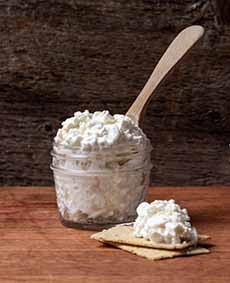
Cottage cheese (photo © Murray’s Cheese). |
COW’S MILK CHEESE
|
Cows are much larger physically and thus produce much more milk by volume than sheep or goats. That’s why many of the largest wheels of cheeses—Cheddar, Comté, and Parmigiano-Reggiano, for example—are made from cow’s milk. Although there is plenty of variation depending on the breed, feed, and other factors, cow’s milk has a sweet yet clean flavor. Cow’s milk contains more fat than goat’s milk, yet less fat than sheep’s milk. See also goat’s milk cheese and sheep’s milk cheese. Cows produce more milk by volume than sheep or goats. This is why many of the largest wheels of cheese are made from cow milk, such as Parmigiano-Reggiano, Comté, and most Cheddar.
|
 |
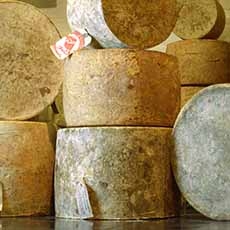
Large wheels of cheese are, of necessity, made of cow’s milk. |
Milked twice a day, cows produce 8-20 quarts per day, goats produce 3-5 quarts of milk and sheep produce one quart of milk. In general, cow’s milk has a sweet yet clean flavor, and of the three milks, cow’s is most able to absorb and develop the intended flavor profile without asserting its own inherent traits. Also, see goat’s milk, sheep’s milk, and water buffalo’s milk.
CREAM
The fatty element of milk.
CREAM CHEESE
A soft, fresh, sweet, mild-tasting cheese. Cream cheese has a high-fat content, at least 33%. The earliest known references to the style of cheese date back to the mid-1600s in France. America’s most prominent brand got its name not because it was created in Philadelphia; it was first made in New York in 1872 by a dairyman named William Lawrence. In 1880, he adopted the brand name “Philadelphia” because that city was known at the time as a center of fine food.
|
 |
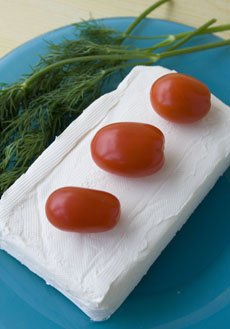
Photo of Philadelphia cream cheese by Claire Freierman | THE NIBBLE. |
CREAMLINE OR CREAM LINE
A cream line" in a cheese refers to the soft, creamy layer that develops just beneath the rind, particularly in soft-ripened cheeses like Brie and Camembert, as the mold on the rind breaks down the cheese paste during aging, creating a gooey, rich texture near the edge; essentially, it's the visible sign of a well-ripened cheese where the rind is actively working on the interior.
|
 |

Truffle Tremor cheese from Cypress Grove, showing a large creamline (photo © Murray’s Cheese). |
CREAMY
A term used to describe the taste, and sometimes the texture, of certain cheeses.
CRÈME FRAÎCHE
Crème fraîche is cultured cream, a thickened cream with a slightly tangy, nutty flavor and velvety, creamy texture. The fresh cream is set aside to let the natural lactic bacteria take over. The bacteria thicken the cream to a consistency and richness almost like sour cream, though with a more delicate texture and tartness. Crème fraîche does not separate or curdle when cooked with wine or at high temperatures, so it is perfect for thickening sauces and soups and imparting rich flavor and texture—it is a staple of French cuisine. The French make crème fraîche with unpasteurized cream; in the U.S., all fresh dairy products (aged fewer than 60 days) must be made with pasteurized milk or cream. Here’s a recipe to make crème fraîche at home. You can make a quickie version by mixing equal amounts of sour cream and heavy whipping cream.
CRESCENZA
Crescenza, a.k.a stracchino, is a staple in Italian kitchens. It’s one of those cheeses that no one has heard of, but everyone loves it when they taste it. An Italian cow's milk cheese, crescenza, is typical of Lombardy, Piedmont, Veneto, and Liguria. It is eaten very young before it develops a rind. It has a very soft, creamy texture and normally a mild and delicate flavor. It is normally square or rectangular in shape.
|
 |
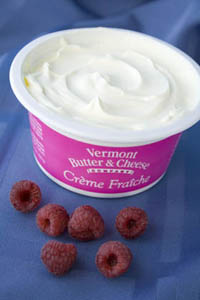
Crème fraîche from Vermont Butter & Cheese Company. Read our review. Photo by Claire Freierman | THE NIBBLE.
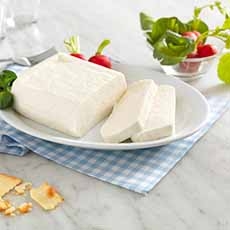
Crescenza cheese (photo © Arrigoni Formaggi). |
CROTTIN
This type of goat cheese is shaped like a drum, but some claim the name means something earthier: Crottin means “dropping” or horse dung in French. The cheese is so-named because as the cheese ages, it becomes dark and hard and bears a resemblance to the animal’s droppings (see photo at right). Crottin is the signature goat cheese shape of the Loire Valley; Crottin de Chavignol, an AOC-designated cheese, has been produced in and around the village of Chavignol since the 16th century. Crottins, which are small in shape, are often served with a salad.
CRUMBLY
A term referring to a cheese that has portions that break off when the cheese is cut. Blue-veined cheeses are particularly crumbly.
|
 |
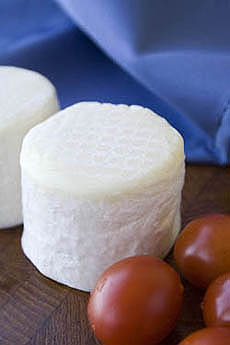
These crottins are made in European fashion by Vermont Butter & Cheese Company. Read our review. Photo by Claire Freierman | THE NIBBLE. |
CRYSTALS
See tyrosines.
CULTURES
Cheese cultures are a group of specific bacterial strains that are combined in order to make a particular type of cheese.
CURD
|
Cheese is made of curds. Curd comes from the Latin word coagulare, meaning to thicken or to clot. Curds are obtained by curdling (coagulating) milk with rennet (an enzyme) or an acid such as lemon juice or vinegar, then draining off the whey. Whey is the liquid portion of milk, which remains after the solids (protein and fat) have been extracted. The solids become curds when an acid (vinegar, lemon juice) or enzymes are added. The curds are broken down in a vat to separate them from the whey. As larger curds contain more water than small curds, a large curd is prepared for soft cheeses, a medium-sized curd for firmer cheeses, and a small curd for hard cheeses. The curds are cut up into lumps, and the curd mass is constantly stirred to prevent it from clumping together again.
|
 |
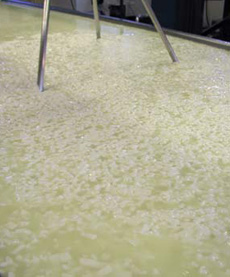
Curds and whey. Photo courtesy of Vella Cheese. |
A draining board or ladles are used to remove the curds from the whey. With pressed cheeses, the whey filters through strong cloth bags that retain the curds. The curds themselves are made up of caseins (large molecules of milk protein) and fat.
CURDING
|
This refers to the temperature at which the cheese is prepared. Raw cheeses are cooked at temperatures that do not exceed 100°F; semi-cooked cheeses are cooked from 100°F to 120°F, and wholly cooked at temperatures over 120°F.
CURDLING
Curdling is an early stage in cheesemaking when milk coagulates after the introduction of rennet.
|
 |
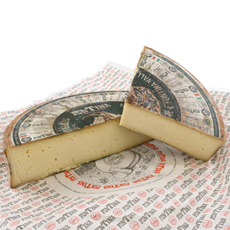
Fontina, a semi-cooked cheese. Available at iGourmet.com. |
CURD MOLDING
|
Curd molding is the stage of cheesemaking in which the cheese curd is ladled into molds that determine the final shape of the cheese: round, rectangular, cylindrical, etc. This process is also known as “hooping the curd.”
CURING or MATURING or AGING
This is the stage in the cheesemaking process when a cheese is left to ripen.
|
 |
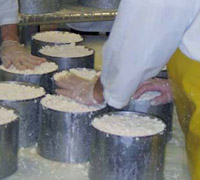
Molding the cheese. Photo courtesy SproutCreekFarm.org |
Continue To Page 4: Terms Beginning With D & E
Go To The Article Index Above
Lifestyle Direct, Inc. All rights reserved. Some material copyright Murray’s Cheese. Images are the copyright of their respective owners.

|
|































